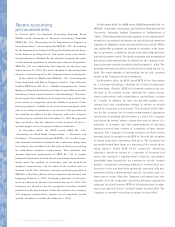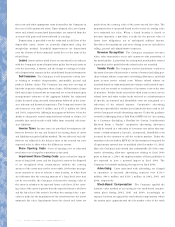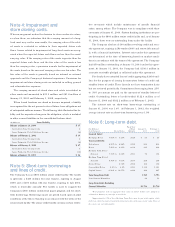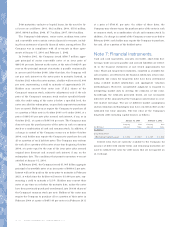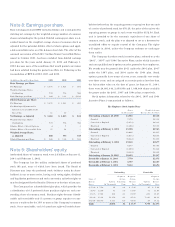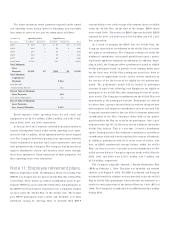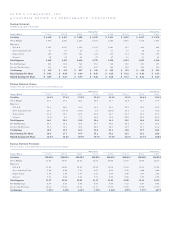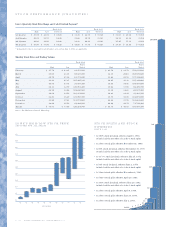Lowe's 2002 Annual Report Download - page 32
Download and view the complete annual report
Please find page 32 of the 2002 Lowe's annual report below. You can navigate through the pages in the report by either clicking on the pages listed below, or by using the keyword search tool below to find specific information within the annual report.
30 / 31 LO WE’S CO MPANIES, INC. ANNUAL REPORT 2002
tion costs and other appropriate costs incurred by the Company in
the case of self-constructed assets. Upon disposal, the cost of prop-
erties and related accumulated depreciation are removed from the
accounts with gains and losses reflected in earnings.
Depreciation is provided over the estimated useful lives of the
depreciable assets. Assets are generally depreciated using the
straight-line method. Leasehold improvements are depreciated
over the shorter of their estimated useful lives or the term of the
related lease.
Leases Assets under capital leases are amortized in accordance
with the Company’s normal depreciation policy for owned assets or
over the lease term, if shorter, and the charge to earnings is includ-
ed in depreciation expense in the consolidated financial statements.
Self-Insurance The Company is self-insured for certain loss-
es relating to worker’s compensation, automobile, general and
product liability claims. The Company has stop loss coverage to
limit the exposure arising from these claims. Self-insurance claims
filed and claims incurred but not reported are accrued based upon
management’s estimates of the aggregate liability for uninsured
claims incurred using actuarial assumptions followed in the insur-
ance industry and historical experience. The Company’s reserve for
self-insurance was $243.5 million and $171.2 million for 2002
and 2001, respectively. Although management believes it has the
ability to adequately record estimated losses related to claims, it is
possible that actual results could differ from recorded self-insur-
ance liabilities.
Income Taxes Income taxes are provided for temporary dif-
ferences between the tax and financial accounting bases of assets
and liabilities using the liability method. The tax effects of such dif-
ferences are reflected in the balance sheet at the enacted tax rates
expected to be in effect when the differences reverse.
Store Opening Costs Costs of opening new or relocated
retail stores are charged to operations as incurred.
Impairment/Store Closing Costs Losses related to impair-
ment of long-lived assets and for long-lived assets to be disposed
of are recognized when circumstances indicate the carrying
amount of the assets may not be recoverable. At the time manage-
ment commits to close or relocate a store location, or when there
are indicators that the carrying amount of a long-lived asset may
not be recoverable, the Company evaluates the carrying value of
the assets in relation to its expected future cash flows. If the carry-
ing value of the assets is greater than the expected future cash flows
and the fair value of the assets is less than the carrying value, a pro-
vision is made for the impairment of the assets based on the assets’
estimated fair value. Impairment losses for closed real estate are
made when the carrying value of the assets exceed fair value. The
impairment loss is measured based on the excess of carrying value
over estimated fair value. When a leased location is closed or
becomes impaired, a provision is made for the present value of
future lease obligations, net of anticipated sublease income.
Provisions for impairment and store closing costs are included in
selling, general and administrative expenses.
Revenue Recognition The Company recognizes revenues
when sales transactions occur and customers take possession of
the merchandise. A provision for anticipated merchandise returns
is provided in the period that the related sales are recorded.
Vendor Funds The Company receives funds from vendors in
the normal course of business for a variety of reasons including pur-
chase volume rebates, cooperative advertising allowances, and third
party in-store service related costs. Volume related rebates are
recorded based on estimated purchase volumes and historical expe-
rience and are treated as a reduction of inventory costs at the time
of purchase. Vendor funds received for third party in-store service
related costs and other vendor funds received as a reimbursement
of specific, incremental and identifiable costs are recognized as a
reduction of the related expense. Cooperative advertising
allowances provided by vendors have historically been used to off-
set the Company’s overall advertising expense. Under the guidance
set forth in Emerging Issues Task Force (EITF) 02-16 “Accounting
by a Customer (Including a Reseller) for Certain Consideration
Received From a Vendor” cooperative advertising allowances
should be treated as a reduction of inventory cost unless they rep-
resent a reimbursement of specific, incremental, identifiable costs
incurred by the customer to sell the vendor’s product. Under the
transition rules set forth in EITF 02-16 this treatment is required for
all agreements entered into or modified after December 31, 2002.
Since the Company had entered into substantially all of the coop-
erative advertising allowance agreements relating to fiscal 2003
prior to January 1, 2003, the implementation of these guidelines is
not expected to have a material impact in fiscal 2003. The
Company is currently analyzing the impact on fiscal 2004.
Advertising Costs associated with advertising are charged
to operations as incurred. Advertising expenses were $114.3
million, $94.3 million and $114.1 million in 2002, 2001 and
2000, respectively.
Stock-Based Compensation The Company applied the
intrinsic value method of accounting for its stock-based compen-
sation plans during 2002, 2001 and 2000. Accordingly, no
expense has been recognized for stock-based compensation where
the option price approximated the fair market value of the stock






